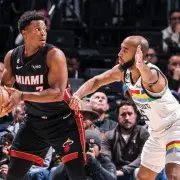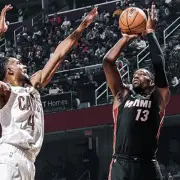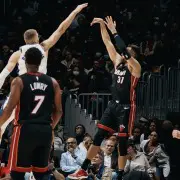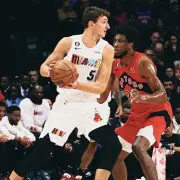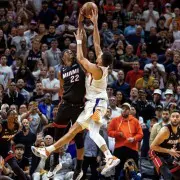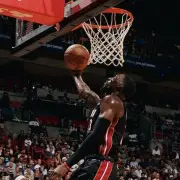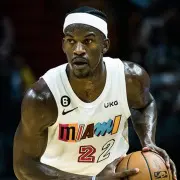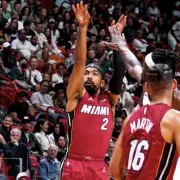Five Takeaways from Heat’s Loss to Timberwolves
The Miami Heat played the Minnesota Timberwolves on the second night of a back to back, and well, they fell yet again.
They came out firing with high energy, but like most nights, it all faded.
Some takeaways:
#1: Heat first half takeaway- intention in two places: boxing out and a shift in the 2-3 zone.
The Heat were coming off a night in Cleveland where they essentially couldn’t defend the Cavs in the 2-3 zone, while also not gobbling up any boards. Yet tonight, it was clear from the jump that they shifted their attention. While the Timberwolves do have a lengthy front-court in Karl Anthony Towns and Rudy Gobert, they have not been a good rebounding team. The Heat, who were much smaller, sent 3 to 4 bodies at the rim for box-outs and crowded boards, sensing some intention. On the 2-3 zone side of things, they were continuing to force the shots in the middle of the floor that I harp on. Towns was getting it to go, but the portion of kick-outs Miami was forcing fell in their favor. Minnesota shot 3 of 25 (12%) in the first half from beyond the arc, which the Heat’s rotations deserve most of that credit. Then the third quarter happened, where all of those numbers were thrown out the window. The timberwolves put up 37 in the third, where Miami shifted to a lot of man, and hit the three at a high clip.
#2: A standout moment from Nikola Jovic.
Nikola Jovic started at the 4 next to Bam Adebayo yet again, but there was less intention to solely feed him early in this game. They wanted to find their base with the Lowry-Bam PnR, then work him in. Yet he wasn’t finding that same rhythm as the outside jumper wasn’t falling, which usually leads into a dark path for young players like himself. But we saw a different response. After some poor offensive possessions, he was crashing the boards and embracing the grab and go system completely. He ran into transition with intention, as Max Strus trotted on his left to the wing. On back to back plays, we saw the same exact formula: transition, Jovic assist, Strus three. For him to be confident enough to run the floor and make decisions after being blitzed early on, that could be one of the most promising signs I’ve seen to date.
#3: Miami’s updated usage of role players…
It’s hard to have offensive diversity when dealing with a short-handed roster with heavy minutes for guys like Haywood Highsmith and Jamal Cain, but Erik Spoelstra found a way to change some minor things up in the first half. With the same roster as last night, minus Duncan Robinson, they needed a positional shift in the half-court for the role players. Banking on threes from Orlando Robinson, Highsmith, and Cain types won’t work when the opposing team is intentionally helping off that corner “spacer.” But the key is they aren’t spacers, so don’t use them as if they are. That was the shift from Miami in this one, as they just constantly sent those two young wings streaking down open lanes and cutting to create some chaos. Highsmith and Cain went on a 9-0 run by themselves in that first half, hammering that alone. Then that led into Highsmith knocking down the outside jumper, which absolutely opens up their half-court offense when dealing with that weak-side helper.
#4: The ball-handling reps for Miami are eye opening with short-handed roster.
As I talked about after last night’s game, one of the main issues with the offense was the lack of shot creation from the guards. Every two-man action is run through two different guys: Kyle Lowry, who we know as the primary set-up man generally, and Max Strus. They were running high PnR after high PnR for Strus in this one, not because there was a match-up they liked, but due to the fact that was their only option. Yes they have Bam Adebayo and Nikola Jovic, but they aren’t guard creators that are necessary to run a consistent high powered offense. Many of the creators should be back after this one, but it’s pretty clear that there’s a lot on the plate of Lowry at the moment as the sole option in the ball-handling room.
#5: Late-game execution watch…
With 5 minutes left in this game, the Heat trailed by 3. The Lowry-Bam PnR spam continued, and the Heat couldn’t hit open threes. Not only could they not make those shots, but free throws were bouncing out. The offense for Minnesota was consistently on the shoulders of Anthony Edwards, who had a big night, yet he kept walking away with empty possessions. Bam Adebayo walked into a pull-up mid range jumper under four minutes to go, tying this one up at 99. Back on the other end, a foul was called on Kyle Lowry who felt he got all ball with a block on McDaniels, which Miami challenged and won. Big swing for the time being. After a miss for Miami, Russell hit a baseline jumper to take the lead by 2. Shortly after, Lowry took a charge on the driving Towns to foul him out of the game, showing some more hope. But well, that faded quickly. The Heat’s offense didn’t show up for most of this one, and a late step back three from Strus summed it all up. They don’t have options at the moment.
